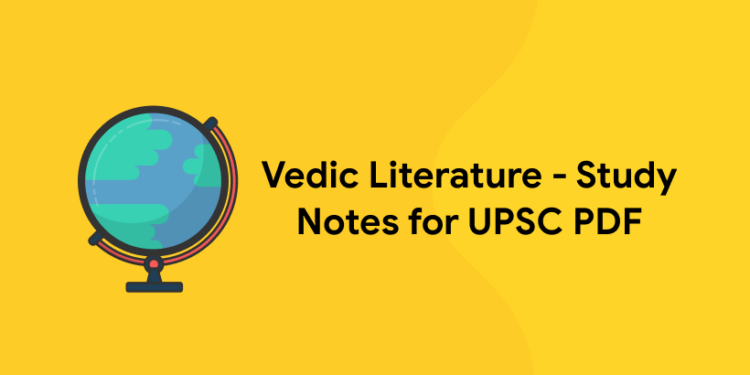Table of Contents
Vedic Literature has always been in an impeccable study position in ancient Indian history because it is one of the oldest literatures in India. Vedic literature throws light into the transition of prehistoric period to historic period since it provides the written records of the past. Vedic period is simply meant by the period where the Vedas are written. All the literature which is written at the time of the Vedic period is called the Vedic literature. Which means Vedic literature not only comprises Vedas only but more. To study Vedas is more controversial in today’s time because it consists of all the past social orders which enforced the inequality in the society. But to know our past is investable. Vedic literature should be given utmost importance to study and to know how the social orders and inequalities started to flourish in the Indian society where the clutches of it are still prevailing. Apart from the religious perspective let us look into the history and facts of the Vedic literature.
Vedic Literature Background
Vedic literature is the literature of the vedic period. Vedic period is the period where the Vedas are written.. This is a self explanatory definition which does not give you much idea about the factors caused in the evolution of the Vedic literature. It is after the invasions of Aryans from central Asia that waves caused the emergence of the Vedic age. They were speaking Sanskrit and had cattle rearing as the main mode of living. They were patriarchal advocates and did rituals. These invasions caused the evolution of Vedas which gave way to the evolution Vedic age.
Vedic Literature: Basic Classification
1: Who was the first woman President of India?
There is so much Vedic literature that is now studied and analyzed. All the Vedic literature can be classified into two depending upon the type of writing it followed. The basic classification of the Vedic literature comprises of :
- Shruthi
- Smrithi
Shruthi
Shruthi means what is heard or listened to. It basically means the literature has been written by what is heard from God. The god has told them to write it and those are called Sruthi. Since it was considered to be heard from god there it starts the religious foundation and supremacy of Vedic literature over other literatures. The Sruthi literature consists of Vedas, Aryankas, Brahmanas and Upanishids. These are considered as the compilation of the revelation towards all the doubts.
Register in to get the latest Exam Study Materials, PDFs, Video Lessons, Mock Tests! Limited Offer!
Smrithi
Smrithis are something which are remembered. They have secondary authority considered to be Shruthi. Smrithis are the creations of the seer and sages. Smrithi literature falls under the post vedic or later vedic literature. They can be philosophies or stories etc. It may or may not be changed over time. Depending upon the type the major smrithis are classified into Vedanga, Puranas, Upaveda, Tantras etc.
Shruthi – Vedas.
The word Veda derived from the word Vid which means to know. It basically implies superior knowledge. Vedas consist of 4 Vedas mainly such as Rig Veda, Yajur Veda, Sama Veda and Atharva Veda. The Rigveda is the oldest of all vedas and it consists of 1028 hymns. Those were sung in praise of different gods. The Yajur Veda consists of various details of rules to be observed at the time of sacrifice. Sama Veda is said to be the tune of mantras. Every mantra should be chanted in such a prescribed way to have its effect. So Samaveda is the Veda which prescribes how it should be pronounced. Atharva Veda contains the details of the rituals.
Register in to get the latest Exam Study Materials, PDFs, Video Lessons, Mock Tests! Limited Offer!
Each Veda consists of 4 parts such as Samhithas, Brahmans, Aranyakas, Upanishids. Samhithas also called hymns is a collection of Mantras or hymns. Brahmanas are the ritualist text which proposes the detailed guidelines of rituals to be performed. The Aranyakas means the forest texts. It basically includes theologies. It has been formulated by the meditating Aryans at the forests. Upanishids are also called the philosophy part. It is the concluding part of the Vedas. It contains the moral and essence of all the Vedas in a concluding nature.
Smrithi – Vedic literature
Vedanga: Vednaga can be literally understood as the limbs of vedas. The limbs of human beings are used to support the human movement. The limbs of Vedas are for studying the vedas. It consists of 6 disciplines such as Siksha, Chhanda, Vyakarana, Nirukta, Jyotisha and Kalpa. Shikhsa are entitled for the study of the correct pronunciation of words or syllables including intonation, Conjunction (Sandhi), disjunction (vichched) of syllables. Chhanda is used for studying the meter used in hymns. Every hymn should be pronounced in the prescribed meter. The meter used to pronounce the hymn is called pada (foot). Chhanda Shastra of Pingalanaga which is written during the period of 5th to 6th century BC is considered to be the oldest text written on this subject. Vyakarana as it means in Malayalam as well as Sanskrit, it literally deals with the grammar of the words, word formation, complex sentences. Ashtadhayayi is one of the most prominent and oldest texts dealing with this subject. Niruktha deals with the etymological meanings of the words and interpretation of phrases and sentences used in Vedas. The most prominent work of nirukta was done by Yakhsa who lived in panini. Jyothisha deals with the astronomical and astrological part of fixing auspicious time for performing vedic rituals. This kind of work and practice is still followed in many of the regions in our society. They are determined by the position of the luminous body in the sky. Aryabhatiya of Aryabhatta and Panchasiddhantham of Varahamihira are the important works in this chapter. Kalpa deals with the practical side of the Vedas. Kalpa is prominently divided into two, Srauta Sutras and Smarthasutras.
Puranas: Puranas are the encyclopedia regarding various topics like cosmology, folk tales, theology,pilgrimage etc. Krishna Dvaipayana, the son of Parasara who is also known as Vyasa is said to be the compiler of puranas from time to time. Puranas are mainly divided into 18 and minor divided into 18 which is also called the upapuranas. Together it consists of more than 400,000 verses (slokas). The 18 major divisions of the Puranas fall under the head of Sattvic or Vaishnava Puranas, Rajasic or Brahma Puranas and tasmic or Shiva Puranas.
Upaveda: There are mainly 4 upavedas named Dhanurveda, Gandharvedha, Ayurveda and arthashastra. Some schools accept Sthapitanonda instead of arthashastra. Dhanurveda deals with warfare science. Gandharva Veda deals with music, dance, poetry, sculpture, erotica and every kind of art. Ayurveda deals with medicine and treatment. This branch of medicine and treatment is recognised by modern medical science too. Arthasthara deals with public administration and financial management.
Register in to get the latest Exam Study Materials, PDFs, Video Lessons, Mock Tests! Limited Offer!
Tantra: Tantra text gave way to the development of Hindu and Buddhist philosophy that all the aspects of material life infuse to the feminine power. Some tantras prescribe sexual rites for the achievement of complete enlightenment. Sexual rites can be considered as literally and symbolically too. The old concept of human life is depicted as Dharma, Artha, Moksha, Kama. Here Kama achievement can be literally prescribed in some tantras.
Conclusion
This article is not aimed at the teachings of the arya samaj which says return to vedas. It’s just aiming to look back to the Vedic literature to know what it was. What all things need to be accepted and what all things need to be ignored to have a progressive human life. In exam point of view, UPSC, SSC and PSC of the new pattern ask various kinds of questions from this part. Understand the factual basis of the Vedic literature in a period where we need to understand the true meaning and actual significance of all these literatures. Keep studying, Keep winning.













